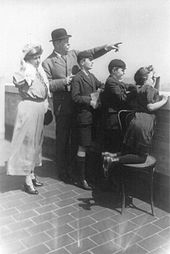Arthur Conan Doyle
| |||||||||||||||||
|---|---|---|---|---|---|---|---|---|---|---|---|---|---|---|---|---|---|
Early life
Arthur Conan Doyle was born the third of ten siblings on 22 May 1859 in Edinburgh, Scotland.[3] His father, Charles Altamont Doyle, who was born in England of Irish descent, and his mother, born Mary Foley, who was Irish, had married in 1855. Doyle's father died in 1893, in the Crichton Royal, Dumfries, after many years of psychiatric illness.[4]Although he is now referred to as "Conan Doyle", the origin of this compound surname (if that is how he meant it to be understood) is uncertain. The entry in which his baptism is recorded in the register of St Mary's Cathedral in Edinburgh gives "Arthur Ignatius Conan" as his Christian name, and simply "Doyle" as his surname. It also names Michael Conan as his godfather.[5]
Conan Doyle was sent to the Roman Catholic Jesuit preparatory school Hodder Place, Stonyhurst, at the age of nine. He then went on to Stonyhurst College until 1875.
From 1876 to 1881 he studied medicine at the University of Edinburgh, including a period working in the town of Aston (now a district of Birmingham) and in Sheffield.[6] While studying, Conan Doyle also began writing short stories; his first published story appeared in Chambers's Edinburgh Journal before he was 20.[7] Following his term at university, he was employed as a ship's surgeon on the SS Mayumba during a voyage to the West African coast. He completed his doctorate on the subject of tabes dorsalis in 1885.[8]
[edit] Origins of Sherlock Holmes
In 1882 he joined former classmate George Budd as his partner at a medical practice in Plymouth,[9] but their relationship proved difficult, and Conan Doyle soon left to set up an independent practice.[10] Arriving in Portsmouth in June of that year with less than £10 to his name, he set up a medical practice at 1 Bush Villas in Elm Grove, Southsea.[11] The practice was initially not very successful; while waiting for patients, Conan Doyle again began writing stories and composed his first novel—The Narrative of John Smith—which would go unpublished until 2011.[12] His first significant work, A Study in Scarlet, appeared in Beeton's Christmas Annual for 1887. It featured the first appearance of Sherlock Holmes, who was partially modelled after his former university teacher Joseph Bell. Conan Doyle wrote to him, "It is most certainly to you that I owe Sherlock Holmes. ... [R]ound the centre of deduction and inference and observation which I have heard you inculcate I have tried to build up a man."[13] Future short stories featuring Sherlock Holmes were published in the English Strand Magazine. Robert Louis Stevenson was able, even in faraway Samoa, to recognise the strong similarity between Joseph Bell and Sherlock Holmes: "[M]y compliments on your very ingenious and very interesting adventures of Sherlock Holmes. ... [C]an this be my old friend Joe Bell?"[14] Other authors sometimes suggest additional influences—for instance, the famous Edgar Allan Poe character C. Auguste Dupin.[15]
Death" of Sherlock Holmes
In 1890 Conan Doyle studied ophthalmology in Vienna, and moved to London in 1891 to set up a practice as an ophthalmologist. He wrote in his autobiography that not a single patient crossed his door. This gave him more time for writing, and in November 1891 he wrote to his mother: "I think of slaying Holmes ... and winding him up for good and all. He takes my mind from better things." His mother responded, "You may do what you deem fit, but the crowds will not take this lightheartedly."
In December 1893, in order to dedicate more of his time to more "important" works—his historical novels— Conan Doyle had Holmes and Professor Moriarty apparently plunge to their deaths together down the Reichenbach Falls in the story "The Final Problem". Public outcry, however, led him to bring the character back in 1901, in The Hound of the Baskervilles. In "The Adventure of the Empty House", it was explained that only Moriarty had fallen; but since Holmes had other dangerous enemies—especially Colonel Sebastian Moran—he had arranged to also be temporarily "dead". Holmes ultimately was featured in a total of 56 short stories and four Conan Doyle novels, and has since appeared in many novels and stories by other authors.





This sites are publish a results.Many learners cannot complete the different demands of teachers with value to essay writing project. Also, popular of learners don't have good writing skills and cannot Essay writing service reviews make efficient essay. Therefore, the best choice for such learners remains to be trust on custom essay writing service.
ReplyDelete